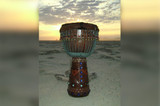Djembe Drumming and the Jeli
The history of Djembe drums holds a deep significance in the lives of many hand drummers today. As a centuries-old instrument, Djembe drums have been used throughout West Africa in various ceremonies, festivals and as a means of communication over long distances. While modern day Djembe drummers come from all walks of life, traditionally, a group of artists that included a Djembe drummer, vocalist and storyteller in West Africa belonged to a caste called “Jeli,” and were responsible for keeping and telling the history of the tribes through music.
The very construction of a Djembe is a spiritual process in the tribal lands of West Africa, requiring offerings to be made to the tree from which the Djembe is carved and even to the animal used for the drum head skin. The blacksmith who fashioned the drum was given a special status within the tribe, as well, and was considered a part of the drum’s spiritual essence. Because of the reverent process of making a Djembe, the final product would ultimately require highly trained musicians and artists to bring out the magic and mystery of the drum. These Jeli were of a few, distinct family lines within the tribes, and tasked with the sole purpose of creating music and retelling the legends and triumphs of the tribes and culture throughout the Mali Empire.
The Jeli consist of three different parts – the Kuma, or those who verbalize the stories and “spoken word” aspect of the music, the Donkili, or singers/vocalists and the Maninka, the drummers and instrument players. These men and women were essentially the traveling musicians and bards of West Africa, helping to keep the history of the tribes documented through song. Even today, the Jeli retain a prominent position within West Africa, continuing the traditional role as musical historians during celebrations like weddings and other rituals.
The Jeli were considered to be highly trained musicians and vocalists, and remain a vital part of modern day life in West Africa. Because of the special reverence paid to the Djembe drum and its history throughout West Africa, the presence of the Jeli continues to bring joy and a sense of history to the drum, even in a modern, American drum circle.
Recent Posts
-
What is the Best Size Djembe for Beginners?
If you're new to the world of percussion and interested in learning the djembe, you're in for a t …16th Jul 2024 -
The Benefits of Becoming a Drumming Teacher: Transforming Passion into Profession
Why become a drumming teacher? Becoming a drumming teacher is an excellent way to share your pas …22nd May 2024 -
What Makes the Djembe Drum a Spiritual Instrument in African Music?
Origin and history of the Djembe drum The Djembe drum originates from West Africa and holds sign …16th May 2024



